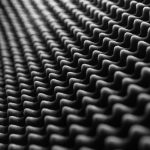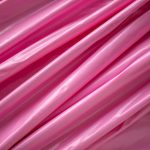To figure out if organza is pure, I start by feeling its texture. Real silk organza should feel a bit stiff and crisp, not slippery. It'll hold its shape well and make a subtle rustling sound. I also do a burn test: genuine silk organza burns with a small flame and smells a bit like burning hair, leaving soft, powdery ash behind. Plus, I always check the fabric's weave— it should be tight and even. Don't forget to hold it up to the light. If it's pure, it'll glow softly and diffuse shadows nicely. These simple checks really help me spot the genuine article. Want to learn some more tricks to spot the real deal? Stay tuned.
Table of Contents
Key Takeaways
- Perform a burn test: Pure organza smells like burning hair and leaves soft, powdery ash.
- Check the texture: Pure organza feels crisp, stiff, and smooth, not slippery.
- Examine the weave: Look for a tight, even, and meticulous weave with no inconsistencies.
- Test with water: Pure organza repels water, causing droplets to form on the surface.
- Assess transparency: Hold the fabric up to light to ensure it allows soft light penetration and shows gentle sheerness.
Understanding Organza Fabric
Organza is a lightweight, sheer fabric traditionally made from silk, though modern versions often incorporate synthetic fibers like polyester or nylon. It's known for its crisp drape and delicate texture, making it a favorite for evening wear, bridal gowns, and haute couture fashion. I've always been fascinated by how this fabric can be both fragile and robust at the same time.
The real charm of organza lies in its transparency and the way it moves. It's not just about how it looks but how it feels between your fingers. When you handle organza, it should have a slight stiffness, a whispery sound when the layers rub against each other. This characteristic rustle is often referred to by fabric connoisseurs as 'scroop.'
Using organza in sewing demands a bit of skill. You've got to be gentle yet precise with your stitches to avoid pulling or puckering the fabric. It's also crucial to choose the right kind of needle and thread to maintain the integrity of the weave.
Understanding these nuances isn't just about getting to grips with a type of fabric; it's about mastering the art of working with materials that can transform an ordinary outfit into something ethereal.
Types of Organza Fibers
When we talk about organza, it's important to know there are different types based on the fibers used.
We've got silk organza, which is the classic and luxurious type, synthetic organza that's more affordable and widely used, and blended organza that mixes qualities of both.
Understanding these types can really help you pick the right fabric for your needs.
Silk Organza Characteristics
Exploring silk organza reveals its unique, sheer texture and smooth, crisp feel, making it a favorite for luxurious garments. It's derived from silk fibers, which give it a high-quality look that's both delicate and strong.
When I handle silk organza, I notice it's slightly stiffer compared to other fabrics, which is why it's often used in bridal wear and evening gowns to create more structured designs. It also has a subtle luster that adds a touch of elegance. The fabric's lightweight nature allows it to drape beautifully, yet it retains shapes well due to its firmness.
To really master your understanding, remember that its natural fiber composition means it's breathable and comfortable, although it requires careful maintenance to keep its pristine condition.
Synthetic Organza Varieties
In contrast to silk organza, synthetic varieties are made from man-made fibers like polyester and nylon, offering different properties and lower costs. These materials make synthetic organza more accessible and versatile. For example, polyester organza is incredibly durable and resists shrinking and wrinkling, which is great for items that need to hold their shape. Nylon organza, on the other hand, is softer and has a slightly different sheen, making it ideal for certain fashion applications.
Both types are used extensively in fashion and décor due to their affordability and adaptability. They handle print well and can be dyed in a variety of vibrant colors, which makes them popular for decorative purposes. They're also easier to maintain compared to their silk counterpart.
Blended Organza Features
Blended organza combines the best of both worlds, mixing natural and synthetic fibers to create versatile fabrics with unique properties. When I explore different types of blended organza, I find a few common combinations that stand out:
- Silk-Polyester: Balances the sheen of silk with the durability of polyester.
- Cotton-Polyester: Merges cotton's softness with polyester's strength.
- Silk-Nylon: Combines silk's luxurious feel with nylon's elasticity.
- Wool-Silk: Fuses wool's warmth with silk's smooth texture.
These blends not only enhance the fabric's usability but also cater to various fashion needs, from flowy evening gowns to structured bridal wear. Understanding these blends helps me appreciate the craftsmanship behind each piece of fabric.
Characteristics of Pure Organza
Pure organza stands out for its crisp texture and sheer, lightweight feel. When I'm handling this fabric, I can't help but notice its distinctive stiffness and structured drape, which make it a favorite for creating voluminous dresses and evening gowns. The sheer nature of pure organza gives it a delicate transparency that's both elegant and playful.
One of the key characteristics I look for is the fabric's composition. True organza is made from silk, giving it a luxurious sheen that synthetic versions just can't match. This natural fiber contributes to its breathability, making it surprisingly comfortable despite its structured appearance. I've also observed that pure organza maintains a beautiful luster that enhances its color depth, providing a rich visual experience that's quite distinct from lesser fabrics.
Durability is another aspect I consider. While it might seem delicate, pure silk organza is actually quite strong and resistant to tears, thanks to the tightness of its weave. This resilience makes it an excellent choice for heirloom pieces that require a fabric capable of withstanding the test of time.
In mastering the identification of pure organza, these factors are crucial. They help ensure that you're investing in a fabric that not only looks spectacular but also performs exceptionally over time.
Texture and Hand Feel Test
To determine if you're dealing with pure organza, start by feeling the fabric between your fingers. It's all about getting a tactile sense of the material. Pure organza has unique characteristics that set it apart from synthetic blends, and you can usually tell by a simple hand feel test.
Here's what to look for:
- Crispness: Pure organza should feel slightly stiff and crisp. It's not as soft as silk organza, but it should still have a structured drape.
- Smoothness: Run your fingers along the fabric. It should feel smooth, but not slippery. Synthetic organzas can sometimes have an overly sleek texture that feels artificial.
- Body: Lift the fabric up. Pure organza holds its shape well and doesn't cling to your hands. It should float gently, reflecting its lightweight nature.
- Sound: Give it a gentle shake. Pure organza typically makes a subtle, rustling sound, a bit like taffeta. This is due to its tight weave and natural fiber content.
Burn Test for Fiber Content
Next up, let's talk about the burn test, which is a great way to figure out what your organza is really made of.
We'll look at how the fabric burns and what kind of ash it leaves behind.
This can tell us a lot about the true content of the fibers.
Identifying Burn Characteristics
One effective way to determine if your fabric is genuine organza is by conducting a burn test. Here's what you need to look for:
- Flame Type: Pure organza, made from silk, will burn with a steady, small flame.
- Smoke Color: When it burns, observe the color of the smoke. Silk organza typically emits minimal smoke that's light gray.
- Smell: As it burns, pure silk organza gives off a smell similar to burning hair.
- Burn Rate: It burns slowly compared to synthetic fibers, which often flare up quickly.
Assessing Ash Residue
After the burn test, examining the ash residue can further confirm if your fabric is genuine organza. Here's how I go about it: If the fabric is pure silk organza, the ash should be soft and powdery, with a light, almost fluffy texture. It'll crumble easily between your fingers. This happens because silk is a natural protein fiber, and when it burns, it leaves behind fine, soft ash.
However, if you're dealing with synthetic fibers like polyester, the residue will be quite different. You'll find hard, bead-like structures that don't crumble. These beads form because synthetics melt rather than burn completely. Knowing this subtle difference helps me determine the real deal from the fakes, ensuring I'm working with high-quality material.
Water Test for Fabric Purity
To test the purity of organza, simply dip a sample in water and observe how it behaves. It's a straightforward method that helps differentiate high-quality organza from lower-grade materials. Here's how you can do it:
- Prepare your sample: Cut a small piece of the organza fabric. Make sure it's clean to avoid skewed results.
- Fill a bowl with water: Use room temperature water to ensure the fabric's reaction is natural.
- Submerge the fabric: Gently place the organza in the water and let it sit for a minute.
- Observe the results: Watch how the fabric interacts with the water.
Pure organza tends to have a somewhat resistant behavior to water, thanks to its silk or synthetic composition. It shouldn't immediately soak up water like a sponge. Instead, you'll notice that it repels water at first, causing droplets to form on the surface.
This isn't a foolproof test, but it gives a good initial indication of the fabric's quality and composition. Remember, mastering fabric identification takes patience and practice, so don't hesitate to repeat the test if you're unsure of your first results.
Examining Fabric Weave
Now let's look at how the weave of organza can also tell us about its purity and quality. When I get my hands on a piece of organza, the first thing I do is closely examine the weave. Pure organza is known for its tight, even, and crosswise weave. This unique characteristic isn't just for show; it speaks volumes about the fabric's integrity and strength.
The weave of high-quality organza should appear uniform and meticulous. If you spot any inconsistencies or loose threads, that's a red flag. These irregularities often suggest a blend, where other fibers are mixed with silk to cut costs, compromising the fabric's overall quality and feel.
I also pay attention to the texture. Pure silk organza has a crispness that's quite distinctive. If the fabric feels overly soft or limp, it might be a sign that it's not 100% silk. Remember, the goal here is to ensure you're getting the real deal, which not only looks better but also lasts longer.
Understanding these details has helped me make more informed choices when shopping for fabric. It's all about knowing what to look for and asking the right questions. Keep these tips in mind, and you'll be on your way to mastering the art of identifying pure organza.
Transparency and Sheerness
When I look at pure organza, I always check how much light passes through it. This helps me understand its transparency and sheer nature.
Comparing its thickness to other fabrics also gives me a good idea of its quality and authenticity.
Assessing Light Penetration
Often, you can gauge the purity of organza by how much light passes through the fabric. When assessing light penetration, here's what to look for:
- Hold it up to light: Pure organza should allow light to filter through easily, showcasing its sheer nature.
- Check the glow: The fabric should glow softly when backlit, without looking too opaque.
- Observe the shadows: Pure organza casts gentle, diffused shadows, indicating its fine texture.
- Compare with known samples: If possible, compare the light penetration with samples of known purity to feel more confident in your assessment.
This simple method helps me ensure the organza I'm considering is of high quality and hasn't been mixed with heavier materials.
Comparing Fabric Thickness
Assessing the thickness of organza involves comparing its transparency and sheerness to other fabrics. Organza's unique texture is thinner and more transparent than many fabrics, making it perfect for delicate, airy designs. Here's a quick comparison to help you see the differences clearly:
| Fabric | Transparency Level |
|---|---|
| Organza | High |
| Cotton | Low |
| Polyester | Medium |
As you can see, organza stands out for its high transparency, which is a key indicator of its purity and quality. When you're handling organza, feel for its crispness and look how it plays with light — the more transparent, the more likely it's of high quality. This simple check is a great way to ensure you're getting the real deal.
Comparing Weight and Density
To differentiate pure organza, comparing its weight and density is essential. When I'm checking fabrics, I've found that the feel and heft of the material can tell you a lot. Pure organza, traditionally made from silk, is notably lighter and airier compared to blends which often incorporate polyester or nylon that increase the weight and alter the texture.
Here's how I break it down:
- Sheerness: Pure organza is more transparent. It's lighter and the weave is less dense, which contributes to its airy feel.
- Texture: It should feel smooth and slightly crisp. If it's rough or stiff, chances are it's not 100% silk organza.
- Drape: The fabric should fall softly and not clump or feel bulky. This is indicative of its low density and high quality.
- Lift Test: Lifting the fabric should feel like it almost floats. Heavier fabrics will drop more quickly and feel denser in your hands.
Understanding these aspects has really sharpened my ability to spot the real deal. It's all about getting familiar with the fabric's fundamental characteristics and trusting your senses to guide you through.
Tips for Buying Genuine Organza
Now that you know how to identify pure organza, let's discuss some practical tips for purchasing this authentic fabric. First off, always buy from reputable sellers. Whether you're shopping online or in a store, stick to well-known retailers or specialized fabric shops. They're more likely to provide high-quality, genuine organza, and they often have knowledgeable staff who can answer any questions.
Next, ask for fabric specifics. Don't hesitate to inquire about the fiber content and country of origin. Pure organza is usually made from silk, though modern versions can also be composed of polyester or nylon. Knowing exactly what you're buying helps ensure you get the real deal.
Also, feel the fabric. Pure organza has a unique crispness and a slightly textured feel that you'll begin to recognize once you've handled it a few times. If it feels too slick or overly smooth, it might be a synthetic blend, not pure organza.
Lastly, check the price. If it seems too good to be true, it probably is. Pure organza, especially silk-based, can be quite pricey. Cheap pricing can often indicate a lower quality or a counterfeit product. Investing in genuine organza means paying for craftsmanship and quality.
Frequently Asked Questions
Can Pure Organza Be Dyed at Home Successfully?
As they say, "Where there's a will, there's a way." I've found you can dye pure organza at home, but it requires careful handling and the right type of dye for success.
How Should Organza Garments Be Stored?
I store my organza garments by hanging them in a cool, dry closet. I use padded hangers to avoid creases and never store them in plastic as it can trap moisture.
Is Pure Organza Suitable for Outdoor Events?
I'd say pure organza is great for outdoor events. It's lightweight and looks elegant, but keep in mind it's delicate and might not handle rough weather like wind or rain very well.
What Are Common Allergens in Organza Fabrics?
Common allergens in organza fabrics include chemical residues from dyes and finishes. I'm always careful to check the fabric composition and processing methods to avoid any allergic reactions when choosing organza.
Does Organza Shrink After Washing?
Opening Pandora's box of laundry challenges, I've found that organza can indeed shrink after washing, especially if it's pure silk. It's best to stick to cold water and avoid the dryer.
- Tetron Fabric for Marine Applications: Durability and Use Cases - June 18, 2025
- Tetron Fabric for Outdoor Furniture: Weather Resistance and Care - June 18, 2025
- Tetron Fabric for Wall Coverings: Style and Application Tips - June 18, 2025







